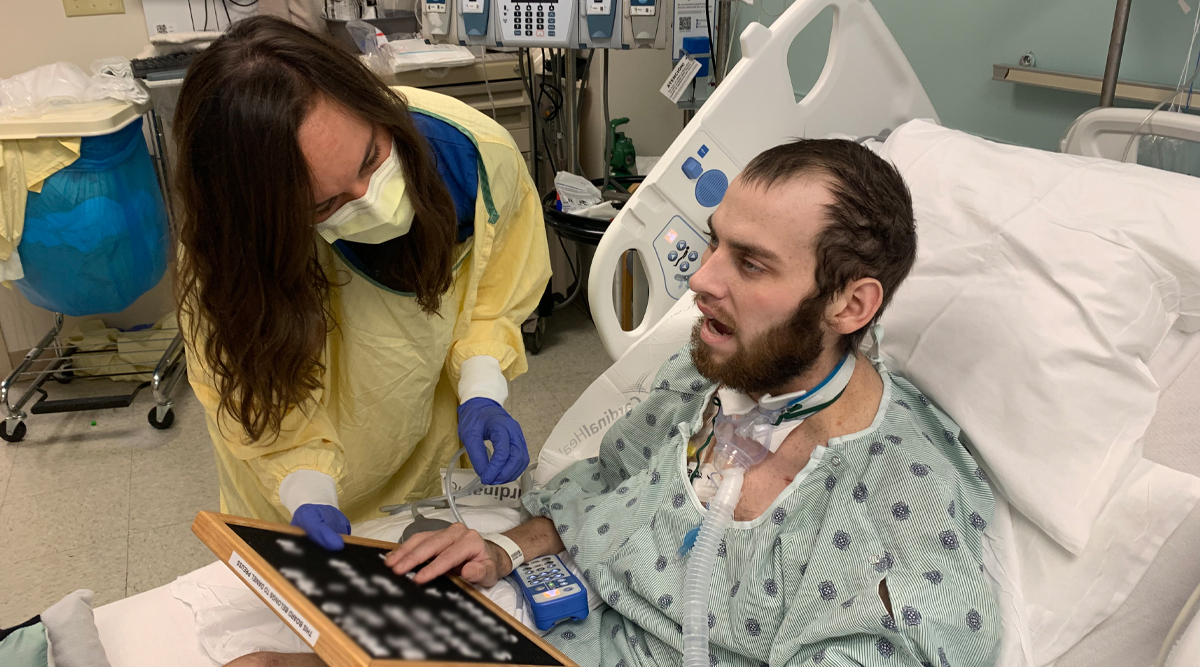At first they knew the patient could not convey his thoughts and feelings but they were not sure why. It took a team to evaluate the situation. Together they came up with a plan.
By IU Health Senior Journalist, T.J. Banes, tfender1@IUHealth.org
Sitting in a chair in the surgical progressive care unit of IU Health University Hospital, Daniel Preuss says four words: “Can you help me?”
He was uncomfortable in his chair and wanted to readjust. His nurse calls for physical therapy and in minutes, Preuss’ fingers are flying across a small letter board. Preuss, 24, came to IU Health to be treated for lymphoma.
In critical condition, Preuss was hospitalized for 60 days, and in a coma for a month. As his condition began to improve, a ventilator and tracheotomy limited his ability to verbalize his needs, said Elizabeth Dimick, occupational therapist.
“His arms were so weak that he also could not use them to point or gesture to what he needed. He would verbalize his needs when he figured out someone was in the room when they touched him,” said Dimick. He became frustrated.
That was when Preuss’ team of rehabilitation specialists came together to design a plan that would help with communication.
That team included Dimick, Jamie Pulliza, manager of adult speech language pathology, Stephanie Roberts, speech pathologist, Dr. Laura Prince, who specializes in physical medicine and rehabilitation, Christa Kaeser, physical therapist, and Megan O’Brien, speech pathologist.
“I admit that when Megan (O’Brien) called me to discuss the case I was momentarily taken aback on how to help this patient because his situation was unique,” said Pulliza. “We looped in two of our speech language pathology colleagues who specialize in neurologic deficits, Andrea Schaeff and Jill Stewart.
Plans began to formulate once the team realized that Pruess has significant visual and hearing impairments. The acute loss was a result of his initial diagnosis and its effect on his central nervous system said O’Brien, who has been with IU Health for nine months. “His hearing is limited to high pitched sounds but he can’t discriminate speech sounds,” she said.
The team members first wrote with their fingertips on Preuss’ palm. One hand squeeze meant, “Yes;” two squeezes, meant, “No.”
“The consistency in how we all write letters, orientation of his palm and the accuracy of him interpreting our ‘handwriting’ was becoming taxing on him and extremely frustrating,” said Dimick. Then the team discussed the patient’s strengths and decided to try a modified letter board. Preuss did not know Braille, but he could feel shapes of letters.
He quickly responded to questions and statements about his care.

“He adapted so readily that they could not keep up the pace communicating with him. There were many tears shed during the process,” said Pulliza. The tears were a result of frustration and joy.
In the end, determination and persistence triumphed.
As Kaeser worked to reposition Pruess in the comfort of his hospital bed, she gave credit to the young man in her care.
“He has been so patient through all of this,” she said. As he began to communicate, his team members saw his mood and interactions shift. He began smiling and joking. He went from being lonely and afraid to recognizing the advocacy of his care team.
Kaeser first met Pruess when he was in medical intensive care. “He asked if I was his mother and I wrote on his hand that I was his physical therapist and his mother would be here soon.”
It was when the team members were searching online for special devices to communicate with Pruess that Kaeser looked at the changeable letter board on her desk. A lightbulb went off and suddenly the team had a solution.
“I feel like he trusts me and I needed to stay with him when he moved to progressive care,” said Kaeser, who has been with IU Health for 10 years. “This is a first. I’ve never had a patient with dual sensory impairments. Writing on his hand and seeing him respond was probably one of the coolest things I’ve done as a physical therapist,” she said. “I feel like without all of us working together and collaborating we would never haver reached this point and this is no doubt, one of the most important things I’ve experienced in acute patient care.”
